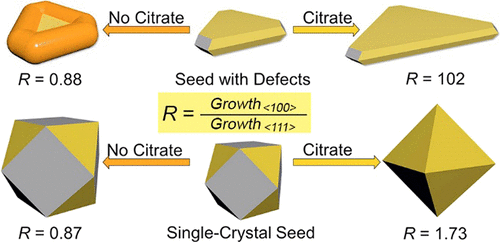当前位置:
X-MOL 学术
›
Chem. Mater.
›
论文详情
Our official English website, www.x-mol.net, welcomes your
feedback! (Note: you will need to create a separate account there.)
The Roles of Citrate and Defects in the Anisotropic Growth of Ag Nanostructures
Chemistry of Materials ( IF 7.2 ) Pub Date : 2021-10-19 , DOI: 10.1021/acs.chemmater.1c02474 Heng Xu 1 , Benjamin J. Wiley 1
Chemistry of Materials ( IF 7.2 ) Pub Date : 2021-10-19 , DOI: 10.1021/acs.chemmater.1c02474 Heng Xu 1 , Benjamin J. Wiley 1
Affiliation

|
Synthetic control of nanocrystal shape is often achieved by controlling the crystal structure of the seed crystals as well as through the use of additives that are thought to block atomic addition to certain facets. However, the effect of the crystal structure or additives on the rate of atomic addition to a specific facet is not usually quantified, making it difficult to understand and design nanocrystal syntheses. This article combines single-crystal electrochemistry measurements with measurements of anisotropic nanocrystal growth to quantify the roles of citrate and planar defects in anisotropic atomic addition. Citrate lowers the rate of atomic addition to Ag(100) and Ag(111) single crystals by 3.2 and 15 times, respectively. Citrate decreases the rate of ascorbic acid oxidation in a facet-selective manner, but citrate decreases the rate of silver ion reduction to roughly the same extent on Ag(100) and Ag(111) single crystals. The degree to which citrate passivates single-crystal electrodes at different citrate concentrations closely matches the facet-dependent growth rates for single-crystal seeds. In contrast, seeds with planar defects exhibit anisotropic growth that is 30–100 times greater than can be explained by the facet-selective passivation by citrate. Without citrate, more silver deposits on the edges of seeds with planar defects than in the middle, but the seeds do not exhibit anisotropic growth. Evidence suggests that citrate improves the stability of nanoplates bounded by large {111} facets by preventing diffusion to {111} facets.
中文翻译:

柠檬酸盐和缺陷在银纳米结构各向异性生长中的作用
纳米晶体形状的合成控制通常是通过控制晶种的晶体结构以及通过使用被认为阻止原子加成到某些方面的添加剂来实现的。然而,晶体结构或添加剂对特定晶面原子添加速率的影响通常无法量化,这使得理解和设计纳米晶体合成变得困难。本文将单晶电化学测量与各向异性纳米晶体生长的测量相结合,以量化柠檬酸盐和平面缺陷在各向异性原子加成中的作用。柠檬酸盐使 Ag(100) 和 Ag(111) 单晶的原子加成速率分别降低了 3.2 倍和 15 倍。柠檬酸盐以小面选择性的方式降低抗坏血酸氧化的速率,但柠檬酸盐将银离子还原速率降低到与 Ag(100) 和 Ag(111) 单晶大致相同的程度。柠檬酸盐在不同柠檬酸盐浓度下钝化单晶电极的程度与单晶种子的晶面依赖性生长速率密切匹配。相比之下,具有平面缺陷的种子表现出的各向异性生长比柠檬酸盐的小面选择性钝化所能解释的大 30-100 倍。在没有柠檬酸盐的情况下,具有平面缺陷的种子边缘上沉积的银比中间多,但种子不表现出各向异性生长。有证据表明,柠檬酸盐通过防止扩散到 {111} 面,提高了以大 {111} 面为界的纳米片的稳定性。柠檬酸盐在不同柠檬酸盐浓度下钝化单晶电极的程度与单晶种子的晶面依赖性生长速率密切匹配。相比之下,具有平面缺陷的种子表现出的各向异性生长比柠檬酸盐的小面选择性钝化所能解释的大 30-100 倍。在没有柠檬酸盐的情况下,具有平面缺陷的种子边缘上沉积的银比中间多,但种子不表现出各向异性生长。有证据表明,柠檬酸盐通过防止扩散到 {111} 面,提高了以大 {111} 面为界的纳米片的稳定性。柠檬酸盐在不同柠檬酸盐浓度下钝化单晶电极的程度与单晶种子的晶面依赖性生长速率密切匹配。相比之下,具有平面缺陷的种子表现出的各向异性生长比柠檬酸盐的小面选择性钝化所能解释的大 30-100 倍。在没有柠檬酸盐的情况下,具有平面缺陷的种子边缘上沉积的银比中间多,但种子不表现出各向异性生长。有证据表明,柠檬酸盐通过防止扩散到 {111} 面,提高了以大 {111} 面为界的纳米片的稳定性。具有平面缺陷的种子表现出的各向异性生长比柠檬酸盐的小面选择性钝化所解释的大 30-100 倍。在没有柠檬酸盐的情况下,具有平面缺陷的种子边缘上沉积的银比中间多,但种子不表现出各向异性生长。有证据表明,柠檬酸盐通过防止扩散到 {111} 面,提高了以大 {111} 面为界的纳米片的稳定性。具有平面缺陷的种子表现出的各向异性生长比柠檬酸盐的小面选择性钝化所解释的大 30-100 倍。在没有柠檬酸盐的情况下,具有平面缺陷的种子边缘上沉积的银比中间多,但种子不表现出各向异性生长。有证据表明,柠檬酸盐通过防止扩散到 {111} 面,提高了以大 {111} 面为界的纳米片的稳定性。
更新日期:2021-11-09
中文翻译:

柠檬酸盐和缺陷在银纳米结构各向异性生长中的作用
纳米晶体形状的合成控制通常是通过控制晶种的晶体结构以及通过使用被认为阻止原子加成到某些方面的添加剂来实现的。然而,晶体结构或添加剂对特定晶面原子添加速率的影响通常无法量化,这使得理解和设计纳米晶体合成变得困难。本文将单晶电化学测量与各向异性纳米晶体生长的测量相结合,以量化柠檬酸盐和平面缺陷在各向异性原子加成中的作用。柠檬酸盐使 Ag(100) 和 Ag(111) 单晶的原子加成速率分别降低了 3.2 倍和 15 倍。柠檬酸盐以小面选择性的方式降低抗坏血酸氧化的速率,但柠檬酸盐将银离子还原速率降低到与 Ag(100) 和 Ag(111) 单晶大致相同的程度。柠檬酸盐在不同柠檬酸盐浓度下钝化单晶电极的程度与单晶种子的晶面依赖性生长速率密切匹配。相比之下,具有平面缺陷的种子表现出的各向异性生长比柠檬酸盐的小面选择性钝化所能解释的大 30-100 倍。在没有柠檬酸盐的情况下,具有平面缺陷的种子边缘上沉积的银比中间多,但种子不表现出各向异性生长。有证据表明,柠檬酸盐通过防止扩散到 {111} 面,提高了以大 {111} 面为界的纳米片的稳定性。柠檬酸盐在不同柠檬酸盐浓度下钝化单晶电极的程度与单晶种子的晶面依赖性生长速率密切匹配。相比之下,具有平面缺陷的种子表现出的各向异性生长比柠檬酸盐的小面选择性钝化所能解释的大 30-100 倍。在没有柠檬酸盐的情况下,具有平面缺陷的种子边缘上沉积的银比中间多,但种子不表现出各向异性生长。有证据表明,柠檬酸盐通过防止扩散到 {111} 面,提高了以大 {111} 面为界的纳米片的稳定性。柠檬酸盐在不同柠檬酸盐浓度下钝化单晶电极的程度与单晶种子的晶面依赖性生长速率密切匹配。相比之下,具有平面缺陷的种子表现出的各向异性生长比柠檬酸盐的小面选择性钝化所能解释的大 30-100 倍。在没有柠檬酸盐的情况下,具有平面缺陷的种子边缘上沉积的银比中间多,但种子不表现出各向异性生长。有证据表明,柠檬酸盐通过防止扩散到 {111} 面,提高了以大 {111} 面为界的纳米片的稳定性。具有平面缺陷的种子表现出的各向异性生长比柠檬酸盐的小面选择性钝化所解释的大 30-100 倍。在没有柠檬酸盐的情况下,具有平面缺陷的种子边缘上沉积的银比中间多,但种子不表现出各向异性生长。有证据表明,柠檬酸盐通过防止扩散到 {111} 面,提高了以大 {111} 面为界的纳米片的稳定性。具有平面缺陷的种子表现出的各向异性生长比柠檬酸盐的小面选择性钝化所解释的大 30-100 倍。在没有柠檬酸盐的情况下,具有平面缺陷的种子边缘上沉积的银比中间多,但种子不表现出各向异性生长。有证据表明,柠檬酸盐通过防止扩散到 {111} 面,提高了以大 {111} 面为界的纳米片的稳定性。











































 京公网安备 11010802027423号
京公网安备 11010802027423号